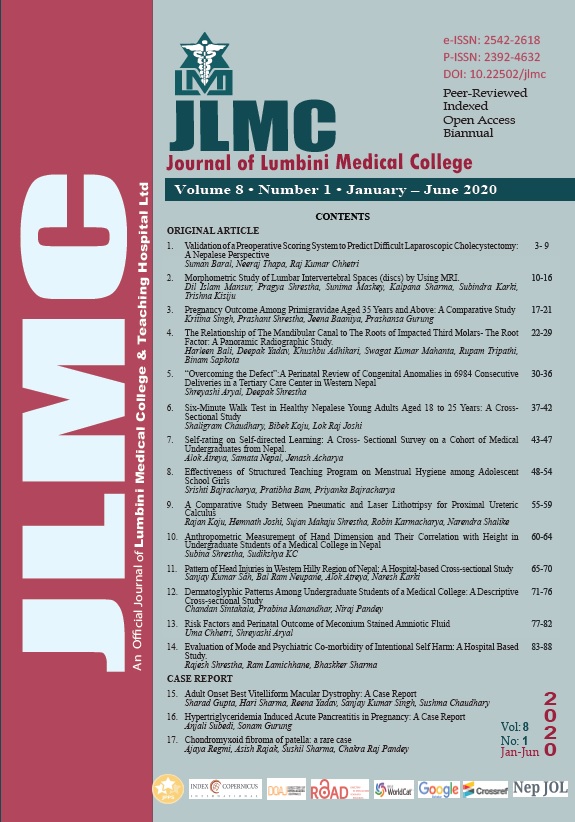Risk Factors and Perinatal Outcome of Meconium Stained Amniotic Fluid
Keywords:
Amniotic fluid, Meconium aspiration syndromeAbstract
Introduction: Meconium Stained Amniotic Fluid (MSAF) is a frequent finding during deliveries and is a cause for perinatal morbidity and mortality. Meconium Aspiration Syndrome (MAS) in neonates is an association in these deliveries with some infants requiring mechanical ventilation. This study was done with the aim of finding the risk factors for MSAF and its perinatal outcome.
Methods: This was a hospital based, cross-sectional study. All the inborn babies delivered with MSAF were included in the study. Antenatal risk factors and perinatal outcomes like mode of delivery, Apgar score, NICU admission and neonatal morbidities mainly MAS were noted.
Results: MSAF was seen in 202 (13.6%) neonates out of which 30 (15%)developed MAS. Antenatal risk factors were present in 97 (48%) cases. Mode of delivery was caesarean section in 78 (39%) and instrumental in 25 (13%) cases. Twenty three percent of the neonates required resuscitation at birth while 34% required respiratory support. Morbidities observed were meconium aspiration, pneumonia, septicaemia, perinatal asphyxia, shock, meconium gastritis and persistent pulmonary hypertension. Neonatal mortality amongst all neonates with meconium was 1.5%.
Conclusion: Meconium stained amniotic fluid leading to aspiration is a significant cause of neonatal mortality and morbidity. Most of the risk factors for MAS are preventable.
Downloads
Downloads
Published
How to Cite
Issue
Section
License
Copyright (c) 2020 Uma Devi Chhetri, Shreyashi Aryal

This work is licensed under a Creative Commons Attribution 4.0 International License.
The Journal of Lumbini Medical College (JLMC) publishes open access articles under the terms of the Creative Commons Attribution(CC BY) License which permits use, distribution and reproduction in any medium, provided the original work is properly cited.JLMC requires an exclusive licence allowing to publish the article in print and online.
The corresponding author should read and agree to the following statement before submission of the manuscript for publication,
License agreement
In submitting an article to Journal of Lumbini Medical College (JLMC) I certify that:
- I am authorized by my co-authors to enter into these arrangements.
- I warrant, on behalf of myself and my co-authors, that:
- the article is original, has not been formally published in any other peer-reviewed journal, is not under consideration by any other journal and does not infringe any existing copyright or any other third party rights;
- I am/we are the sole author(s) of the article and have full authority to enter into this agreement and in granting rights to JLMC are not in breach of any other obligation;
- the article contains nothing that is unlawful, libellous, or which would, if published, constitute a breach of contract or of confidence or of commitment given to secrecy;
- I/we have taken due care to ensure the integrity of the article. To my/our - and currently accepted scientific - knowledge all statements contained in it purporting to be facts are true and any formula or instruction contained in the article will not, if followed accurately, cause any injury, illness or damage to the user.
- I, and all co-authors, agree that the article, if editorially accepted for publication, shall be licensed under the Creative Commons Attribution License 4.0. If the law requires that the article be published in the public domain, I/we will notify JLMC at the time of submission, and in such cases the article shall be released under the Creative Commons 1.0 Public Domain Dedication waiver. For the avoidance of doubt it is stated that sections 1 and 2 of this license agreement shall apply and prevail regardless of whether the article is published under Creative Commons Attribution License 4.0 or the Creative Commons 1.0 Public Domain Dedication waiver.
- I, and all co-authors, agree that, if the article is editorially accepted for publication in JLMC, data included in the article shall be made available under the Creative Commons 1.0 Public Domain Dedication waiver, unless otherwise stated. For the avoidance of doubt it is stated that sections 1, 2, and 3 of this license agreement shall apply and prevail.
Please visit Creative Commons web page for details of the terms.




